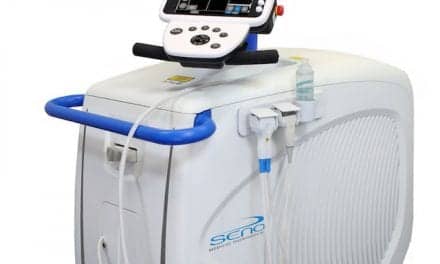Transitioning to digital mammography can be a boon in today’s tough times.

|
As the only imaging study regulated by the federal government, mammography has always occupied a difficult position in the menu of imaging services.Thanks to aggressive publicity campaigns, many women—due to their own insistence or that of their primary physician—get regular mammograms. However, because of regulation by the federal government, traditional mammograms are, at best, a loss leader with months’-long waiting lists. For many imaging centers, mammography is offered more as a necessary public service that dedicated radiologists provide even in the face of heightened liability because of their commitment to women’s health.
But all that is changing. Digital radiology has changed the landscape for many types of scans from traditional x-ray to high-end PET imaging to everything in between. Mammography is finally joining the digital revolution, and a new class of workstations and software is making this test easier to read, efficient, more effective and, for the first time since it’s been regulated by the government, profitable for many centers.

|
| Christine M. Keefe, CPA, CMPE |
And even better, radiologists and administrators have a number of options to choose from to tailor these workstations to fit their particular needs.
Merge Workstation
Christine M. Keefe, CPA, CMPE, chief financial officer of St Louis-based Metro Imaging, was an early adopter of Merge Healthcare’s Mammo Workstation. A longtime Merge customer, the five-office, five-radiologist group was looking for a way to read its digital mammography imaging studies.
There are a number of criteria that the group was looking at when evaluating various systems. Among the requirements was that the system had to be easy to support, could be integrated into the existing PACS, had to have computer-aided detection (CAD), and had to work in a multispecialty imaging center. After looking at other vendors’ systems, Keefe decided to stick with Merge.
Originally, there was a concern that digital mammography took longer to read and was less efficient. In fact, the radiologists have found it easier to work with the images and their outcomes have been better, particularly when they’ve compared the quality of the digital images to traditional film.
Since implementing it in 2005, the year that Merge began offering its Mammo Workstation product to the public, Metro Imaging has realized numerous benefits from its mammo service going digital. The most important was that it erased the patient backlog. This is because the digital exam takes about 20 minutes instead of 30 minutes.
Currently, Merge offers a stand-alone workstation and a software package that can be integrated into a practice’s PACS system. Because Metro Imaging is a multimodality specialty, it was important that it be integrated into the existing PACS system, allowing radiologists to toggle back and forth between mammography and other digital studies. This saves the radiologists time because they don’t have to switch to a dedicated workstation to review a test. According to Merge Healthcare, about 70% of its customers are imaging centers and most of these prefer the PACS software package as opposed to a stand-alone workstation, which makes more sense for a hospital-based imaging service. The Merge Mammo Workstation is vendor and modality neutral, giving it added flexibility.
Having it in the PACS environment helps keep the practice efficient in other ways. Each of the group’s five radiologists is at one of the practice’s five imaging centers located throughout metro St Louis. As part of its patient service, it provides a preliminary report of the findings to the patient before she leaves the office. If the radiologist is tied up in another procedure, the study can be sent to a radiologist at another site for immediate review. Likewise, the files can be sent for a second review to these other sites.
Keefe said that there was some worry that huge imaging files would have to be sent over the network, but, in reality, the CAD file can be sent separately over the network. Having all of the patient files in an electronic format has helped increase efficiency. It is not uncommon for patients to go to different sites for imaging studies. Instead of pulling a physical file and moving it to another site, it can be accessed through Metro Imaging’s PACS system.

|
| The Merge Mammo Workstation is vendor and modality neutral, giving it added flexibility to diverse institutions. |
Support was perhaps one of the biggest needs that Metro Imaging had when making the transition to digital mammography. Because the group is small, there is only one staff member who handles IT issues in addition to facilities management. Merge Healthcare offers a full service package of 24/7 support.
When Metro had the Merge Mammo Workstation integrated into its PACs system, the technician who installed the system worked with the radiologists to make sure that they could confidently use the system. Keefe said that it took 10 minutes to 2 hours for the five radiologists to learn the basics. This was mainly due to the fact that the system worked off of the existing Merge PACS they were used to. In all, the learning curve was about a day.
With all of the support, the mammography part of the PACS causes the least trouble and is regularly updated remotely.
Metro Imaging has proven that digital mammography makes sense. But new players are being convinced every day.
Carestream’s Solution
A number of factors went into Joint Township District Memorial Hospital’s choice of Carestream as its digital mammography workstation provider. Among them was the fact that its radiologists were already familiar with Carestream’s PACS system. “There was a low learning curve. All they had to learn was the mammography toolsets,” said Robert J. Homan, medical imaging/PACS-RIS clinical coordinator for the 110-bed hospital located in St Mary’s, Ohio.
In addition, Carestream’s system offered a level of comfort. The screen mimics a standard film screen, so the radiologists didn’t have to learn to look at the digital images in a different way.
Among the specialized functions Carestream was able to offer were a programmable mouse and a CAD overlay into the image. Because the hospital is small and the department handles a range of modalities, the system has been integrated into its PACS system to allow its radiologists—like the ones at Metro Imaging—to toggle between different modalities with ease.
Outcomes are also much better, according to Homan, particularly in regard to imaging dense breasts. He cites better tools and the use of full-field digital mammography as giving patients and their referring physicians a higher level of “ease and comfort level, because they’re getting the best, state-of-the-art scan,” he said.
In addition, the hospital offers molecular breast imaging, and Carestream supports a dual workstation that allows a comparison between a standard digital image and the molecular one.
Though digital mammography is still relatively new for the hospital, Homan knows that it was the right time to make the transition. “We’re definitely benefiting,” he said.
But, as with most things digital, vendors haven’t been resting on their laurels basking in the glow of satisfied customers. Instead, they’re working hard to keep refining and improving what they’re doing.
Philips’ MammoDiagnost VU
Though not commercially available in the United States—yet—Philips’ MammoDiagnost VU is being tested and refined in imaging departments such as the one at the University of Chicago Medical Center.
Clinicians at the university, such as Gillian Newstead, MD, have been working in collaboration with Philips to develop the MammoDiagnost VU. “We’ve told Philips what we need [as radiologists] and they’ve listened,” she said.
The results, from Newstead’s perspective, have created a system that captures beautiful images and has increased the department’s efficiency. “It’s improved throughput—it’s the fastest in our section right now and has integrated pretty well with our RIS,” she said.
Currently, the system is a stand-alone workstation, but will eventually be integrated into PACS. Integration, particularly in a vendor-neutral setting, has been a key part of the development collaboration. The MammoDiagnost VU also allows imaging departments to read different breast imaging modalities, including DR and CR, seamlessly.
But the MammoDiagnost VU brings a number of other advantages to the table. It has automatic sizing and CAD, and can compare different images taken at different times and from various modalities. It also allows for panning and automatically aligns the breast tissue. This last feature could be a key to saving time and making a better diagnosis. “It lines the nipples up, and that could make a big difference,” said Newstead.
The ability of the MammoDiagnost to automatically size and align the images also helps with outcomes, primarily by saving time, according to Newstead. “Anything that keeps us from having to manipulate the image is a good thing,” she said.
The MammoDiagnost has a double reading function, which, Newstead said, is a nice feature, particularly for academic settings. “It allows this to happen seamlessly,” she said.
With all the new tools that are available, the one piece of the equation that can’t be forgotten is the patient.
Patient Reaction
Metro Imaging’s Keefe says that the reaction of patients to digital mammography has been wholly positive. “It’s their perception that, because it’s digital, it’s better,” she said. “And certainly there’s less radiation.”
This perception could be a key factor in making an imaging center a continued destination for other imaging needs from an x-ray for a sprain to a colonoscopy. Chrysti Bowers, RT, director of clinical solutions at Merge Healthcare’s Fusion Division, notes that the bottom line for all radiology services is that they have to offer mammography. And that’s for one reason—women make 85% of all the health care decisions in the country.
Digital mammography is convenient, can be profitable (see sidebar, above right), and certainly is proving to be as effective as film mammography, if not more so. Coupled with the wide array of mammography workstations, digital mammography is a win-win situation for all concerned.
C.A. Wolski is a contributing writer to Axis Imaging News.






